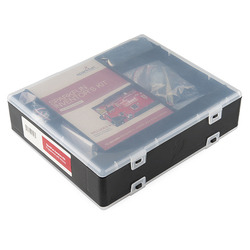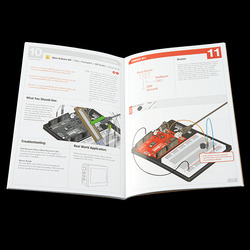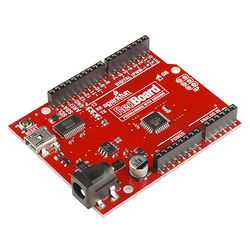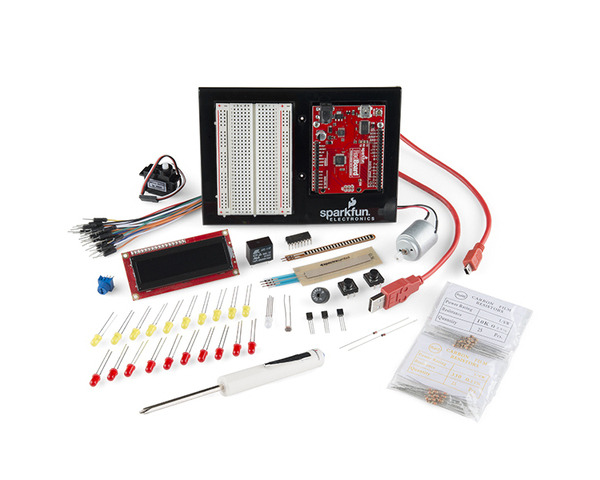SparkFun Inventor's Kit - V3.1 (with Arduino-Compatible RedBoard)
The SparkFun Inventor’s Kit has everything you need to construct a variety of circuits that will teach you how to use an Arduino-compatible RedBoard to read sensors, display information on an LCD, drive motors, and more. No previous programming or electronics experience is necessary, which makes this a great way for beginners to get started with embedded systems. The V3.1 version includes a RedBoard and detailed instructions for building 15 educational circuits with the kit components.
| Description | Specs (0) | Pictures (21) | Resources (5) | FAQs (0) | On the blog (2) | Distributors (0) |
|---|
Note: This product has been replaced by the newer SparkFun Inventor’s Kit – V3.2 (with Arduino-Compatible RedBoard). Version 3.2 adds a new Simon Says circuit with all the LEDs and tactile buttons needed to complete it, and a new full-color guidebook.
 |
SparkFun Inventor’s Kit case. |
|---|
 |
SparkFun Inventor’s Kit V3 and V3.1 guidebook. |
|---|
 |
SparkFun Inventor’s Kit (V3 shown) set up with an example LCD circuit. |
|---|
 |
SparkFun Inventor’s Kit – V3.1 (with RedBoard). |
|---|
 |
SparkFun RedBoard (an Arduino Uno R3 clone). |
|---|
Overview
The SparkFun Inventor’s Kit comes with everything you need to start building circuits right out of the box. It is a great way for beginners to learn the basics of electronic circuits and build familiarity with Arduino. This kit includes an Arduino-compatible SparkFun RedBoard, along with various sensors and indicators, premium jumper wires, a USB cable, a prototyping breadboard, a carrying case, and an instruction booklet. The printed instruction booklet guides you through the construction of 15 basic circuits that will teach you how the various sensors and indicators interface with the RedBoard.
The instruction booklet is designed to teach a beginner how to create the following circuits using the included SparkFun RedBoard:
- Blinking an LED
- Reading a Potentiometer
- Driving and RGB LED
- Driving Multiple LEDs
- Push Buttons
- Reading a Photo Resistor
- Reading a Temperature Sensor
- Driving a Servo Motor
- Using a Flex Sensor
- Reading a Soft Potentiometer
- Using a Buzzer
- Driving a Motor
- Using Relays
- Using a Shift Register
- Using an LCD
These tasks are fundamental building blocks of typical electronics projects. Once these concepts are mastered, they can be combined in various ways to create even more intricate and impressive projects.
The RedBoard functions similarly to an Arduino Uno R3, and has the same microcontroller and bootloader. It also has the same size and footprint, which allows compatibility with most Arduino shields. The RedBoard uses the standard Arduino IDE and can be programmed over the USB A to mini-B cable included in this kit.
For those already somewhat comfortable with electronics, we also offer a SparkFun starter kit for RedBoard, which includes a variety of sensors and indicators to get you started in the wonderful world of embedded electronics and is a great gift for beginners and experienced users alike.
Included Components
- SparkFun RedBoard (an Arduino Uno R3 clone)
- Printed SparkFun Inventor’s Kit guidebook
- Carrying case
- RedBoard and breadboard baseplate
- 6′ USB A-to-Mini B cable
- 16×2 white on black LCD
- Mini screwdriver
- Opaque white 400-pt breadboard
- 74HC595 shift register
- 2N2222 transistors
- 1N4148 diodes
- DC motor with gear
- Small servo
- 5V relay
- TMP36 temperature sensor
- Flex sensor
- Softpot
- Photocell
- Tri-color LED
- Red and yellow LEDs
- 10kΩ potentiometer
- Piezo buzzer
- 12mm pushbuttons
- 330Ω and 10kΩ resistors
- Jumper wires for connections without soldering
This kit is recommended for beginners ages 10 and up. No soldering is required.
If you want to make your Arduino or RedBoard project wireless, please consider adding in our Wixel shield for Arduino.
Note: SparkFun calls this product the “SparkFun Inventor’s Kit – V3.1” SKU: KIT-12001. It replaces the older SparkFun Inventor’s Kit – V3 (the main difference is that V3.1 includes a screwdriver and the breadboard has changed from translucent red to a standard opaque white).





























